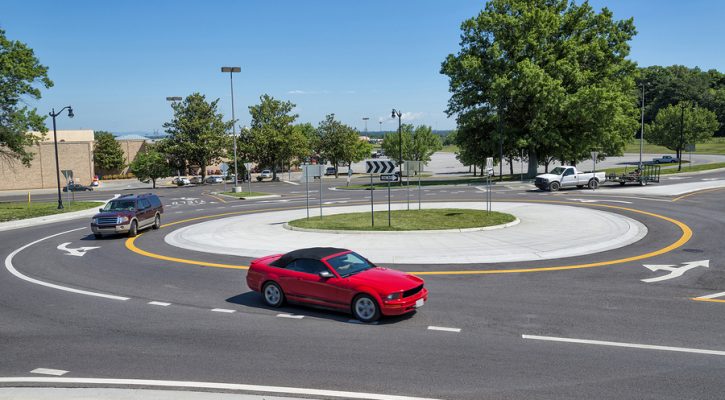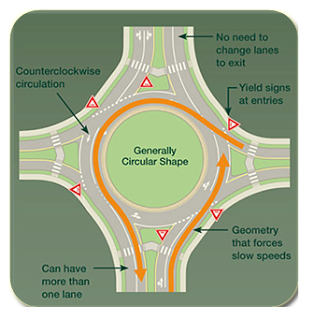Tag Archive: roundabouts

Replacing Signal Intersections With Roundabouts
November 10, 2016
By replacing their signaled intersections with roundabouts , Carmel Indiana, a suburb of Indianapolis, made a bold decision to spend more money up front in order to save a lot more money in the long run. While they were at it, they saved quite a few lives and prevented a lot of injuries.
Roundabouts are intersections designed to keep traffic moving more smoothly through intersections without the need for traffic lights. Roundabouts accomplish their mission by forcing traffic to slow down while allowing traffic from all directions to enter the intersection without having to stop. Since 2001, the city has built or replaced more than 100 intersections using roundabouts and there are plans to build even more. They hope to have the work completed by 2018.
Even though traffic is forced to slow when entering an intersection, it rarely has to stop. However, if a vehicle does need to stop while yielding to another vehicle, it doesn’t have to stop for long. The driver can enter the intersection as soon as traffic is clear without having to wait for a green light. Europe adopted roundabouts long ago and they’re becoming more common every year but the US didn’t adopt the idea until the 1990s and roundabouts here are few and far between.
By replacing their intersections with roundabouts, the city of Carmel saw dramatic results:
- Roundabout construction costs an average of $125,000 less than a signaled intersection.
- No more money is spent on maintaining or replacing traffic signals.
- Roundabouts don’t fail to operate when there’s a power outage.
- Without having to idle while waiting at a light, observations at ten study sites show an average gas savings of 24,000 gallons per year.
- Less gas used means less pollution.
- Each replacement intersection can handle a 30 to 50 percent increase in traffic flow.
- Less time spent in traffic means greater productivity.
- With all traffic going in the same direction, there are fewer serious crashes.
- Head-on and high speed right angle collisions are much less likely at roundabouts.
- Slower speeds give drivers more reaction and decision making time.
- Roundabouts are safer for pedestrians.
- Injury crashes were reduced by almost 80% at intersections replaced by roundabouts.
- Overall, crashes were reduced by 40%.
- Fewer crashes mean lower costs for first responders.
- Fewer crashes mean first responders can focus on other needs.
To save money and lives, more cities and counties need to consider following Carmel’s lead.
For more information, visit: City of Carmel Indiana

Traffic Circles and Roundabouts
December 1, 2011
Traffic circles and roundabouts are a type of road intersection that are gaining popularity throughout the nation. While not really a new idea, they seem to have become more prevalent over the past fifteen to twenty years as city planners and developers seek ways to keep traffic moving more smoothly and safely.
Traffic circles allow traffic to move more smoothly through an intersection without the use of traffic lights by use of a one way circle with “exits” to the intersecting roads. If you have never encountered one, they could be slightly intimidating at first but they are really quite simple and you will find they do keep traffic moving much more smoothly. They also keep the intersection safer by forcing traffic entering the circle to slow down and yield to traffic already in the circle. While traffic must slow to enter the circle, it doesn’t have to stop for red lights which can be especially frustrating when there is no traffic on the cross street.
Most traffic collisions in the US occur at intersections and the most common type of collisions are rear-end collisions. By slowing traffic on entering and keeping all traffic moving in the same direction, traffic circles cut down on the chances for collisions. With no traffic light, there is a zero chance of someone causing a collision by running a red light.
All traffic circles are designed basically the same way. The terms roundabout and traffic circles are often used interchangeably but traffic circles usually refer to larger, multi-lane circles. Traffic entering the circle must slow, wait for an opening in traffic and then enter to the right moving around the circle in a counterclockwise path. Once a driver reaches the “exit” to the road they want to enter, they exit the circle to the right.
If you live in a growing community, you may want to urge your city planners to consider more traffic circles to cut down on traffic congestion.
